Former residents and environmental campaigners to launch a lawsuit against Pentagon’s plans to use the Marianas islands for bombing practice
by Justin McCurry and Daniel Lin
Even here, in a region bursting with natural beauty, it is hard to imagine a more idyllic scene than Green Beach on Pågan island. Azure waters roll ashore before disappearing into the volcanic sand on a perfectly shaped horseshoe beach; on the horizon, cliffs plunge into darker open water that stretches, unhindered, more than 1,600 miles to the north-east coast of the Philippines.
But in just a few years, Pågan’s tranquility could be shattered by the sound of heavy artillery, ending any hopes the displaced people of this 10-mile-long speck in the western Pacific have of returning to their ancestral home, more than three decades after a volcanic eruption forced all 300 residents to flee.
According to plans outlined by the US Department of Defence, as many as 5,000 marines will descend on the island to conduct war games as part of the Obama administration’s pivot towards the Asia-Pacific.
The exercises will not only make human settlement impossible; campaigners say it will lead to the destruction of ancient cultural relics and threaten wildlife, including indigenous endangered animals such as fruit bats and tree snails.
The marines will be among more than 8,000 who are due to be relocated to Guamand Hawaii from Okinawa as part of a controversial agreement between Washington and Tokyo to reduce the US military footprint on the southern Japanese island.
Faced with the near-certain destruction of their homeland – part of the US Commonwealth of the Northern Marianas – dozens of former residents have joined forces with environmental campaigners to launch a lawsuit they hope will expose the folly of the Pentagon’s plans to transform Pågan and Tinian, an inhabited island 200 miles to the south, into simulated theatres of war.
The whole of Pågan would be turned into a simulated war zone to enable troops from the US, and regional allies Japan, South Korea and Australia, to prepare for possible confrontations sparked by China’s military buildup in the South China Sea and its claims to Japanese-administered islands in the East China Sea.
Gus Castro lived on Pågan between the ages of one and five, when he and hundreds of other residents were forced to flee after the catastrophic volcanic eruption of 1981.
He spent much of his life growing up on Saipan before returning to Pågan in 2000 to perform work as a local guide and camp manager for US military contractors that had been sent to build volcano sensors, a communications tower and other facilities. Other former residents lived alongside him on the island intermittently, supported by supplies approved by the mayor of the Northern Islands.
“When I’m living on Saipan, I eat unhealthy food, I drink alcohol and I smoke,” says Castro, a youthful-looking man in his early 40s who this summer joined a photographer, other former residents and campaigners on a visit to Pågan. “In all the years I’ve spent on Pågan, I’ve never been sick once.”
But as soon as Castro, who has ethnic ties to both the indigenous Chamorro people and Caroline islanders, learned of the plans to use Pågan for large-scale target practice, he cut his ties with the US defence department. He left Pagan earlier this year and is living back on Saipan.
Pete Perez and his wife Emma Perez, of the pressure group Pågan Watch, were with Castro on his most recent visit to Pågan. Part-Chamorro themselves, they believe the US navy’s blueprint for the island is fomenting a cultural and environmental catastrophe.
Instead of investing in tourism and infrastructure, US taxpayers are being asked to bankroll the destruction of an entire culture, says Pete. “The northern islands are one of the few options that makes the Commonwealth of the Northern Marianas viable for a sustainable tourism economy.
“If the military takes over, we would lose all those economic possibilities, not to mention the land that future generations of Chamorros can occupy. The proposed activity on Pågan is about destroying culture, destroying land, and creating a 9,000-plus square mile military training ground. And all the while they’re asking the American people to pay for it.”
Few US citizens are aware that Pågan and Tinian – parts of which will be commandeered for drills involving artillery, mortars and inert bombs, causing major disruption to the lives of its 3,000 residents – even exist.
In fact, the Chamorro people first settled here 1,300 years ago, and archaeologists have uncovered evidence of human habitation dating back more than two millennia. The islands’ indigenous people faced deportation during Spanish rule in the late 1600s, and then decades of occupation by Germany and Japan.
Now the US wants to turn their island into a military wasteland, says David Henkin, an attorney at Earthjustice, which is representing environmental and local community organisations.
Their lawsuit, filed in federal court in Saipan in July, alleges that the US navy and defence department did not fulfill a legal requirement to explain publicly the potential effects on residents and the environment, and failed to explore potential alternative sites where the military could accomplish its mission with less harm to the environment.
“The lawsuit’s aim is to force the US navy to be honest about what it needs to do, as distinguished from what it merely wants to do,” Henkin told the Guardian. “The navy needs to make its reasoning known to the American public. We live in a democracy, and if the navy wants to make Pågan uninhabitable and turn Tinian into a living hell for its residents, then it has to explain why before it starts moving thousands of marines to Guam.
“We’re not saying that the marines shouldn’t fulfill their national security mission – it’s the why and where that we’re concerned about.”
Pågan’s location is both a blessing and a curse. On Green Beach, known by local people as I Bandera, stands a stone memorial to fallen soldiers from a Japanese garrison that was based here while imperial Japan built its east Asian empire. Tinian, a Japanese base until it was captured by the US in 1944, played a central role in the Pacific conflict as the departure point for the US B-29 superfortresses that dropped nuclear bombs on Hiroshima and Nagasaki in August 1945.
Henkin believes that forcing the Pentagon into full disclosure about its plans and their impact will take the discussion on Pågan’s fate into the court of public opinion. “When that happens, we are confident that the US public will oppose the move,” he says.
“People feel deep connections to Pågan, and to deprive them of the opportunity to return to this beautiful place is wrong. The thought that this tropical paradise will be destroyed by 2,000-pound bombs in ship-to-shore bombardments is unconscionable.”
If and when the US military does “invade” Pågan, Castro has vowed to form a resistance movement – alone if necessary. “If the military starts bombing, I will be here on the island, ready to protest and defend my homeland,” he says.
“Pågan is the only place on earth where I truly feel connected to the land. I don’t care if I have to wait here for months on my own. I’ll never give up. This is my home.”


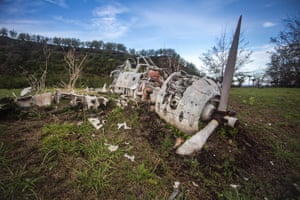
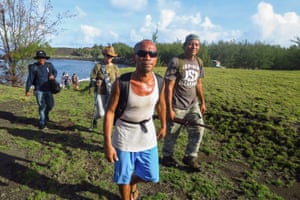

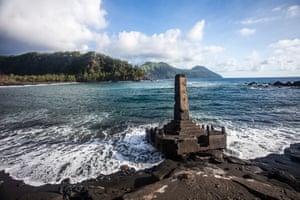
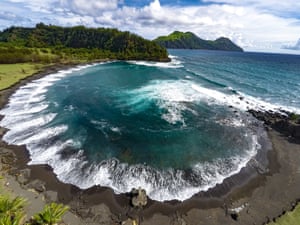
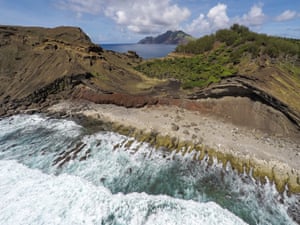
No comments:
Post a Comment